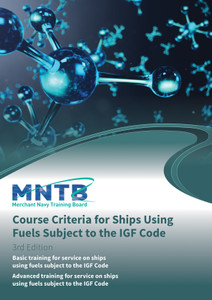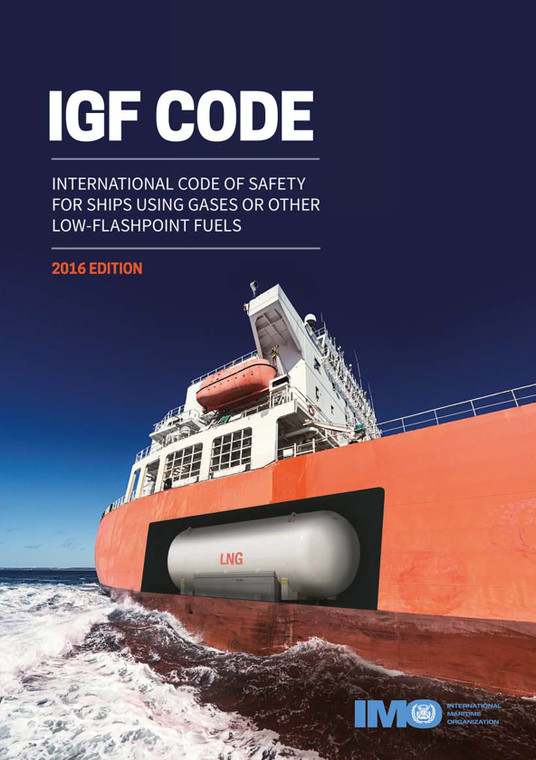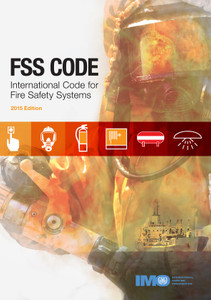
This Code provides an international standard for ships using low-flashpoint fuel, other than ships covered by the IGC Code. The basic philosophy of this Code is to provide mandatory provisions for the arrangement, installation, control and monitoring of machinery, equipment and systems using low-flashpoint fuel to minimize the risk to the ship, its crew and the environment, having regard to the nature of the fuels involved.
The
International
Code
of
Safety
for
Ships
using
Gases
or
other
Low-flashpoint
Fuels
(IGF
Code)
was
adopted
by
the
Maritime
Safety
Committee
(MSC)
at
its
ninety-fifth
session
in
June
2015,
by
resolution
MSC.391(95),
in
order
to
provide
an
international
standard
for
the
safety
for
ships
using
low-flashpoint
fuel,
other
than
ships
covered
by
the
IGC
Code.
The
IGF
Code
is
made
mandatory
under
amendments
to
chapters
II
-1,
II
-2
and
the
appendix
to
the
annex
of
the
International
Convention
for
the
Safety
of
Life
at
Seas
(SOLAS),
1974,
that
were
adopted
by
the
MSC
at
the
same
session,
by
resolution
MSC392(95)
(entry
into
force:
1
January
2017).
The adoption of the IGF Code was the culmination of over 10 years of work by several IMO bodies, starting with the approval by MSC78 (May 2004) of a work item on “Development of provisions for gas-fuelled ships”. Following the adoption by MSC86 (June 2009) of the Interim Guidelines on safety for natural gas-fuelled engine installations in ships (resolution MSC.285(86)), MSC 87 approved the expansion of the scope of the work on development of provisions for gas-fuelled ships to include ships fuelled by low-flashpoint liquid fuels. The present version of the IGF Code includes regulations to meet the functional requirements for natural gas fuel. Regulations for other low-flashpoint fuels will be added as, and when, they are developed by the Organization.
The
International
Code
of
Safety
for
Ships
using
Gases
or
other
Low-flashpoint
Fuels
(IGF
Code)
was
adopted
by
the
Maritime
Safety
Committee
(MSC)
at
its
ninety-fifth
session
in
June
2015,
by
resolution
MSC.391(95),
in
order
to
provide
an
international
standard
for
the
safety
for
ships
using
low-flashpoint
fuel,
other
than
ships
covered
by
the
IG
C
Code.
The
IG
F
Code
is
made
mandatory
under
amendments
to
chapters
II
-1,II
-2
and
the
appendix
to
the
annex
of
the
International
Convention
for
the
Safety
of
Life
at
Seas
(SOLAS),
1974,
that
were
adopted
by
the
MSC
at
the
same
session,
by
resolution
MSC392(95)
(entry
into
force:
1
January
2017).
The
adoption
of
the
IGF
Code
was
the
culmination
of
over
10
years
of
work
by
several
IMO
bodies,
starting
with
the
approval
by
MSC
78
(May
2004)
of
a
work
item
on
“Development
of
provisions
for
gas-fuelled
ships”.
Following
the
adoption
by
MSC
86
(June
2009)
of
the
Interim
Guidelines
on
safety
for
natural
gas-fuelled
engine
installations
in
ships
(resolution
MSC.285(86)),
MSC
87
approved
the
expansion
of
the
scope
of
the
work
on
development
of
provisions
for
gas-fuelled
ships
to
include
ships
fuelled
by
low-flashpoint
liquid
fuels.
The
present
version
of
the
IG
F
Code
includes
regulations
to
meet
the
functional
requirements
for
natural
gas
fuel.
Regulations
for
other
low-flashpoint
fuels
will
be
added
as,
and
when,
they
are
developed
by
the
Organization.
International
Code
of
Safety
for
Ships
using
Gases
or
other
Low-flashpoint
Fuels
(IGF
Code)
Preamble
Resolution
MSC.391(95)
Adoption
of
the
International
Code
of
Safety
for
Ships
using
Gases
or
other
Low-flashpoint
Fuels
(IGF
Code)
Part
A
2
General
2.1
Application
2.2
Definitions
2.3
Alternative
design
3
Goal
and
functional
requirements
3.1
Goal
3.2
Functional
requirements
4
General
requirements
4.1
Goal
4.2
Risk
assessment
4.3
Limitation
of
explosion
consequences
Part
A-1
Specific
requirements
for
ships
using
natural
gas
as
fuel
5
Ship
design
and
arrangement
5.1
Goal
5.2
Functional
requirements
5.3
Regulations
–
General
5.4
Machinery
space
concepts
5.5
Regulations
for
gas
safe
machinery
space
5.6
Regulations
for
ESD-protected
machinery
spaces
5.7
Regulations
for
location
and
protection
of
fuel
piping
5.8
Regulations
for
fuel
preparation
room
design
5.9
Regulations
for
bilge
systems
5.10
Regulations
for
drip
trays
5.11
Regulations
for
arrangement
of
entrances
and
other
openings
in
enclosed
spaces
5.12
Regulations
for
airlocks
6
Fuel
containment
system
6.1
Goal
6.2
Functional
requirements
6.3
Regulations
–
General
6.4
Regulations
for
liquefied
gas
fuel
containment
6.5
Regulations
for
portable
liquefied
gas
fuel
tanks
6.6
Regulations
for
CNG
fuel
containment
6.7
Regulations
for
pressure
relief
system
6.8
Regulations
on
loading
limit
for
liquefied
gas
fuel
tanks
6.9
Regulations
for
the
maintaining
of
fuel
storage
condition
6.10
Regulations
on
atmospheric
control
within
the
fuel
containment
system
6.11
Regulations
on
atmosphere
control
within
fuel
storage
hold
spaces
(Fuel
containment
systems
other
than
type
C
independent
tanks)
6.12
Regulations
on
environmental
control
of
spaces
surrounding
type
C
independent
tanks
6.13
Regulations
on
inerting
6.14
Regulations
on
inert
gas
production
and
storage
on
board
7
Material
and
general
pipe
design
7.1
Goal
7.2
Functional
requirements
7.3
Regulations
for
general
pipe
design
7.4
Regulations
for
materials
8
Bunkering
8.1
Goal
8.2
Functional
requirements
8.3
Regulations
for
bunkering
station
8.4
Regulations
for
manifold
8.5
Regulations
for
bunkering
system
9
Fuel
supply
to
consumers
9.1
Goal
9.2
Functional
requirements
9.3
Regulations
on
redundancy
of
fuel
supply
9.4
Regulations
on
safety
functions
of
gas
supply
system
9.5
Regulations
for
fuel
distribution
outside
of
machinery
space
9.6
Regulations
for
fuel
supply
to
consumers
in
gas-safe
machinery
spaces
9.7
Regulations
for
gas
fuel
supply
to
consumers
in
ESD-protected
machinery
spaces
9.8
Regulations
for
the
design
of
ventilated
duct,
outer
pipe
against
inner
pipe
gas
leakage
9.9
Regulations
for
compressors
and
pumps
10
Power
generation
including
propulsion
and
other
gas
consumers
10.1
Goal
10.2
Functional
requirements
10.3
Regulations
for
internal
combustion
engines
of
piston
type
10.4
Regulations
for
main
and
auxiliary
boilers
10.5
Regulations
for
gas
turbines
11
Fire
safety
11.1
Goal
11.2
Functional
requirements
11.3
Regulations
for
fire
protection
11.4
Regulations
for
fire
main
11.5
Regulations
for
water
spray
system
11.6
Regulations
for
dry
chemical
powder
fire-extinguishing
system
11.7
Regulations
for
fire
detection
and
alarm
system
12
Explosion
prevention
12.1
Goal
12.2
Functional
requirements
12.3
Regulations
–
General
12.4
Regulations
on
area
classification
12.5
Hazardous
area
zones
13
Ventilation
13.1
Goal
13.2
Functional
requirements
13.3
Regulations
–
General
13.4
Regulations
for
tank
connection
space
13.5
Regulations
for
machinery
spaces
13.6
Regulations
for
fuel
preparation
room
13.7
Regulations
for
bunkering
station
13.8
Regulations
for
ducts
and
double
pipes
14
Electrical
installations
14.1
Goal
14.2
Functional
requirements
14.3
Regulations
–
General
15
Control,
monitoring
and
safety
systems
15.1
Goal
15.2
Functional
requirements
15.3
Regulations
–
General
15.4
Regulations
for
bunkering
and
liquefied
gas
fuel
tank
monitoring
15.5
Regulations
for
bunkering
control
15.6
Regulations
for
gas
compressor
monitoring
15.7
Regulations
for
gas
engine
monitoring
15.8
Regulations
for
gas
detection
15.9
Regulations
for
fire
detection
15.10
Regulations
for
ventilation
15.11
Regulations
on
safety
functions
of
fuel
supply
systems
Annex
Standard
for
the
use
of
limit
state
methodologies
in
the
design
of
fuel
containment
systems
of
novel
configuration
Part
B-1
16
Manufacture,
workmanship
and
testing
16.1
General
16.2
General
test
regulations
and
specifications
16.3
Welding
of
metallic
materials
and
non-destructive
testing
for
the
fuel
containment
system
16.4
Other
regulations
for
construction
in
metallic
materials
16.5
Testing
16.6
Welding,
post-weld
heat
treatment
and
non-destructive
testing
16.7
Testing
regulations
Part
C-1
17
Drills
and
emergency
exercises
18
Operation
18.1
Goal
18.2
Functional
requirements
18.3
Regulations
for
maintenance
18.4
Regulations
for
bunkering
operations
18.5
Regulations
for
enclosed
space
entry
18.6
Regulations
for
inerting
and
purging
of
fuel
systems
18.7
Regulations
for
hot
work
on
or
near
fuel
systems
Annex
LNG-bunker
delivery
note
Part
D
19
Training
19.1
Goal
19.2
Functional
requirements
A??s a specialized agency of the United Nations, IMO is the global standard-setting authority for the safety, security and environmental performance of international shipping. Its main role is to create a regulatory framework for the shipping industry that is fair and effective, universally adopted and universally implemented.
In other words, its role is to create a level playing field so that ship operators cannot address their financial issues by simply cutting corners and compromising on safety, security and environmental performance. This approach also encourages innovation and efficiency.
Shipping is a truly international industry, and it can only operate effectively if the regulations and standards are themselves agreed, adopted and implemented on an international basis. IMO is the forum at which this process takes place.
- Number of Pages:
- 118
- ISBN:
- 9789280116533
- Published Date:
- November 2016
- Book Height:
- 210 mm
- Book Width:
- 150 mm
- Author:
IMO
- Preview:
- Yes
- Publication Date:
- February 2021





